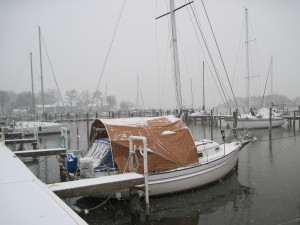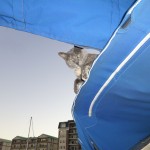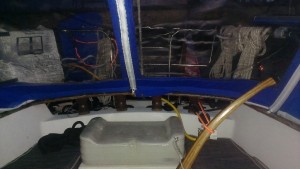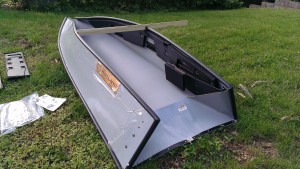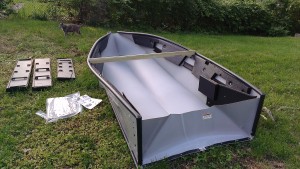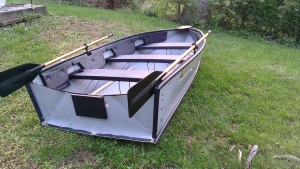I have tankage for twenty gallons of water on board Seeker. Frankly, that isn’t a lot for the extended sailing I have planned and I hope to augment that in the near future. But, given that I have what I have, even on shortish week or two trips it is critical to conserve water.
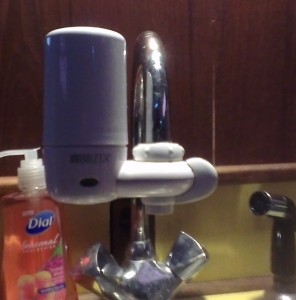 Naturally, some water shouldn’t be conserved. It is important to drink plenty of water, especially in the warmer months. Many people do their drinking solely from disposable plastic water bottles, which is a great way of consuming good tasting, clean water. It’s also expensive and wasteful. Admittedly, I do do this; but I am trying to break myself of the habit. I have installed on the pressure water system a Brita filter which produces fine tasting water from my 30+ year old water tanks.
Naturally, some water shouldn’t be conserved. It is important to drink plenty of water, especially in the warmer months. Many people do their drinking solely from disposable plastic water bottles, which is a great way of consuming good tasting, clean water. It’s also expensive and wasteful. Admittedly, I do do this; but I am trying to break myself of the habit. I have installed on the pressure water system a Brita filter which produces fine tasting water from my 30+ year old water tanks.
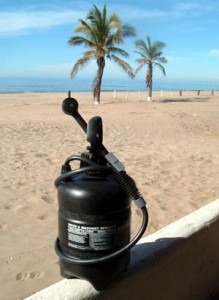 Other daily water uses can easily be reduced. Baby wipes are inexpensive, and wonderful for a daily sponge bath. They aren’t as nice as a real shower, of course; but they do greatly reduce the need of the daily shower dirt dwellers are accustomed to.
Other daily water uses can easily be reduced. Baby wipes are inexpensive, and wonderful for a daily sponge bath. They aren’t as nice as a real shower, of course; but they do greatly reduce the need of the daily shower dirt dwellers are accustomed to.
For an on-board shower I mostly use the Pump Up Solar Shower I found on Duckworksmagazine.com. I can either use it in the head (where I also can use the wasteful, and cold, pressure water shower), or on the deck. I sort of like to sit at the bow with my legs in the anchor locker and clean up there as the second best solution is the cockpit, which I’d much prefer to keep dry and comfortable. I fill this shower before leaving so as to not use the tank water, and find I can comfortably get several showers out of it. The black container also warms up in the sun which is nice. The portable nature of this shower also allows me to rinse off the boat and gear with it, or even dishes if I’m inclined to do them in the cockpit. A real bonus.
Speaking of dishes, I believe that doing them is one of the most wasteful uses of water.
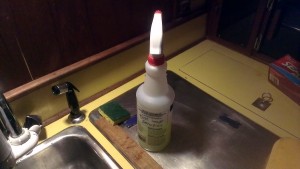
A good way to save water while doing dishes
One solution to this that I found is to mix up some dish soap and water in a heavy duty spray bottle. A few pumps of the lever and the dishes are wet and soapy and ready for cleaning. One bottle lasts a really long time and uses hardly any water. I have been rinsing using pressure water; but I think a separate water only spray bottle would work really well. There is a minor issue with this method. on the bottom of the pickup tube there is a little plastic strainer that the dish soap seems to coagulate around. After a day or two it is necessary to pull the sprayer nozzle and tube and clean off this intake strainer, or the bottle just won’t pump. The strainer itself pulls off easy enough (at least in the bottle I have), so I removed it from mine and will see if the dish soap starts gunking up more important and less easily cleaned parts of the pump works. Either way, I definitely recommend grabbing a bottle or two.
Oh, and a word about pressure water: I’ve always bought into the common knowledge that pressure water equals waste. That may be true if you have dirt dwellers aboard, or maybe teenage girls or something. With a little care, however, I have found that it is real easy to use a miserly trickle of water. I still desire a manual pump; but more as a backup than to save water.
Coming soon eventually: more water tankage. I’m looking at installing a fresh water tank where the holding tank used to be. The holding tank was twenty gallons and ideally I could get the same for fresh water. Sadly, I can’t find an off the shelf thank to properly fit the spot so will likely end up with a smaller 13 gallon flexible tank in that area (that may or may not be able to be fully utilized). I suspect custom tanks would be too expensive, although I suppose I can look into building one myself. I’m also considering installing another twenty gallon tank under the starboard settee. I’m a little uncertain of this one, as I hate to take away too much of my limited stowage. But, I really hate having to dig under the settees anyhow, so maybe the compromise is worth it. I should still have a fair amount of stowage available. Upping my water tankage from twenty gallons to fifty would really extend my range.




